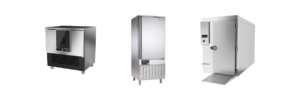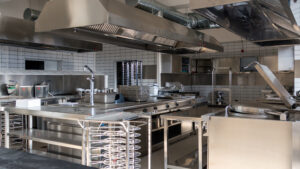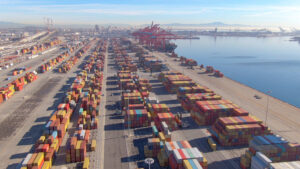Why You Can’t Get Your Commercial Kitchen Equipment: A Breakdown of the Supply Chain Crisis
For the latest supply chain news and information, read our Supply Chain Updates page here.
Times have been tough on the restaurant industry. From complete shutdown to worker shortages, it’s been a time of upheaval for foodservice operators everywhere.
And now, as we come out of the heart of the pandemic and learn to deal with its long-lasting effects, there’s one more problem that’s causing even more trouble: the supply chain crises.
Supply chain challenges are causing big problems in the restaurant industry. To work effectively, supply chains rely on people and equipment. If either is in short supply, the chain suffers. And since the pandemic has created a global shortage on both… we’re in trouble.
Why is there a shortage of restaurant equipment and when will it resolve? Keep reading to find out.
Equipment Shortages Across the Restaurant Industry
According to a recent National Restaurant Association survey, 95% of restaurants have experienced significant supply delays or shortages in recent months.
Equipment has become near impossible to come by, with some critical pieces taking six months to come in. This backlog has become a major concern for anyone looking for almost any type of restaurant equipment, from ovens to freezers to custom food warmers.
“Your question isn’t ‘What’s the cost?’ It’s ‘When can I get it?’” said Avanti CEO Mark Rossi.
This shortage is causing delays across the country, holding up new construction, bringing kitchen remodels to a halt, and delaying new restaurant openings significantly.
Effects on Foodservice Operations

Cost Increases: This extreme equipment shortage has led to an inevitable increase in the price. Naturally, the price of used equipment has soared along with it. Besides these shortages, everything from the cost of raw materials to the fuel it takes to get the equipment to your door has gone up.

Opening Delays: With some equipment taking months to arrive, many restaurants have had to delay their openings. Construction stops when equipment isn’t ready for installation.

Slower Throughput: Some foodservice operators are attempting to make do with the equipment they have, delaying remodels and appliance upgrades. While this is a feasible short-term solution, broken or outdated equipment can slow down food production and lower your throughput.

A Decline in Quality: Just like above, operators who choose to delay their equipment repair or upgrades can often continue serving customers, but with some significant drawbacks. Unreliable appliances can cause problems with the food quality, and if you’re not careful it can cause long-lasting damage to your restaurant’s reputation.
What Happened to the Supply Chain?
Why is this happening? There are many factors in supply chain management that have led to this moment.
Supply chain issues have caused major problems since the pandemic started in late 2019 and early 2020. But the real reason we’re in this mess is because of a history of decisions made by the manufacturing industry.
There are two major factors at play: just-in-time manufacturing and overall supply chain complexity. Both are longstanding practices, but neither was able to withstand a global pandemic.
Just-in-time manufacturing relies on timing the delivery of goods just before you need them to minimize costs and reduce the amount of on-hand inventory.
With a complex supply chain like large restaurant equipment, this can get complicated. Hypothetically, it can go like this: Raw goods are used to make computer chips in Asia. They’re then delivered to a warehouse in Mexico that builds a thermostat. Then, that thermostat enters the US where it’s added to a commercial freezer.
If small delays happen at any point in the above scenario, the entire supply chain is thrown off. And the pandemic caused more than a small delay.
A Supply Chain Timeline
Pre-COVID-19:
US/China Tariffs Increased Demand. People were concerned about prices increasing, so they stocked up on raw materials and components. This led to increased demand on an already tight supply chain.
March 2020:
COVID-19 Upended the Supply Chain. Everything was locked down, and every part of the supply chain was affected. From mines to factories to ports, nothing was made, and nothing moved.
Consumer Demand Increased: People actually purchased more goods because they were confined to their homes. Not only did this increase demand while production was at a standstill, but it also increased demand on residential deliveries.
March 23, 2021:
Ship Ever Given Blocks Suez Canal: 12% of global trade passes through Egypt’s Suez Canal. This 6-day blockage slowed an already-strained supply chain.
Why is There Still a Supply Chain Bottleneck?
So why is there still a supply chain issue now that most industries have gone back to normal? Most news has been centered around the truck driver shortage and a shortage of chassis preventing materials from being unloaded from the ships. But that’s not the only issue.
Logistics can typically survive a minor market shift, but nothing to this scale. When consumer demand increases, they typically add more ships, more trucks, more everything until demand decreases and they have to scale back. With the sudden demand shifts fueled by the pandemic, it just wasn’t able to keep up.
The biggest problem? There are issues at every stage of the supply chain.

Stage 1: Raw Materials Extraction & Component Construction
Lingering raw material shortage from COVID-19 shutdowns
Fewer workers in the mines and manufacturing plants
Transportation and logistics issues within China and other manufacturing countries

Stage 2: Import Shipping & Logistics
Major import harbors such as the Port of Los Angeles have long queues
Once boats dock, there’s a shortage of container chassis
Rail stations are backed up due to fewer available trains
Shortage of truck drivers to get haul products to their destinations

Stage 3: Equipment Assembly
Smaller workforce pool to pull from
Social distancing protocols restrict worker capacity
Built equipment waiting for components takes up space
Manufacturing lines start/stop based on when components are expected to arrive

Stage 4: Last-Mile Delivery
Truck driver shortage extends to last-mile delivery eCommerce increase puts more pressure on FedEx and UPS.
When Will Supply Chain Issues Improve?
According to Rossi, it could be until January 2023 before the restaurant equipment supply chain returns to normal.
But there are a few things you can do about it. Follow these tips to mitigate the effects these delays will have on your restaurant:
- Get in line as soon as you can. Order your equipment at least eight weeks before you think you need it. Sooner if you can swing it.
- Have a backup plan. What will you do if you can’t get the exact piece of equipment you need? Is it possible to hold out even longer? Can you make do with what you have? Is there a slightly different model you can use? Know the answers to these questions before you have to ask them.
- Don’t worry about specifications or customizations. If you’re waiting on a piece of equipment, don’t hold out for the exact one you think you need—you could be waiting a long time. Instead, find something that will work for now and upgrade in the future if you need to.
- Consider used equipment. If you can find what you need out in the used market, go with that option. While it’s getting scarce, there are unfortunately a lot of restaurants that went out of business in the last few years. You might be able to find something that will work in the short term. Even if it’s not ideal, it may be worth it.
- Understand the construction process. Find out when you really need the equipment for installation, not just when it would be ideal to get it. Many contractors want the equipment on-site before they build out the necessary framing, but there might be some creative ways to get around it. Ask questions and see if you can work with your team for the best possible outcome.
- Listen to your vendors. If they tell you they can’t get it, it’s not gettable. New equipment is hard to come by, but used equipment is getting just as scarce. Trying to circumvent your vendors and find equipment elsewhere will just waste your time and cause you even more stress. Just trust that vendors are doing what they can.
What Does the Future Look Like?
We know problems in the food and beverage industry extend beyond restaurant equipment and appliances, but the good news is that there is hope on the horizon. After these prolonged problems, we’ll likely see some lasting improvements in the supply chain.
“[Manufactuing] is moving from just in time to just in case,” predicts Rossi. We’re likely going to see more safety stock and backup components to prepare for future supply chain disruptions.
According to Foodservice, Equipment & Supplies, some companies are even purchasing six months of supply instead of a few weeks to get ahead of demand.
It may take another year before we start to see real improvements, but it will hopefully make for a stronger supply chain in the future.
Work with Avanti to Help You Navigate Supply Chain Issues
Avanti Restaurant Solutions provides equipment sourcing, financing, and commercial kitchen design to foodservice operators around the country. With over 18 years of experience, we can leverage relationships and smart workarounds to get you the equipment you need to get the job done.
Feeling overwhelmed? We’re here to help. We have all of this information and worked into our process. Turn to the experts and we’ll streamline and simplify your commercial kitchen design.









